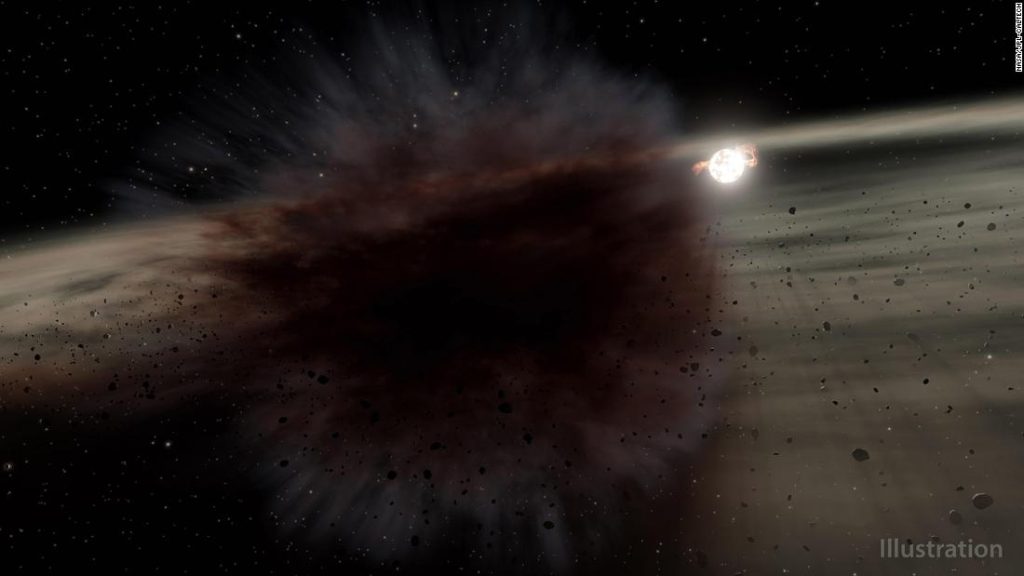
Astronomers had the opportunity to observe a massive, star-sized debris cloud from such a collision as it passed in front of a nearby star and blocked some of its light. This temporary dimming of starlight, known as transits, is often a method used to detect the presence of exoplanets around stars outside our solar system. But this time, the observations revealed evidence of a collision between two celestial bodies potentially the size of giant asteroids or small planets, the scientists said.
A team of astronomers began routinely observing HD 166191, a 10-million-year-old star similar to our sun located 388 light-years away. In 2015. Astrologically speaking, it’s still a fairly young star—considering that our Sun is 4.6 billion years old. At this age, small planets often form around stars. These masses of dust left over from star formation and orbited around it turn into rocky bodies, unlike the asteroids left behind by the formation of our solar system. Small planets around other stars can accumulate material and increase in size, eventually turning into planets.
Gas, which is essential for star formation, is scattered over time between minor planets – so these objects are at increased risk of colliding with each other.
Debris provides clues about the formation of planets
The minor planets are too small to be seen with telescopes, but when they collide with each other, the dust clouds are large enough that they can be observed.
Based on the observable data, the researchers initially believed that the debris cloud had become so elongated that it occupied an area about three times the size of the star – this is a minimal estimate. But Spitzer’s infrared observations saw only a small portion of the cloud pass in front of the star, while the entire debris cloud spanned an area hundreds of times the size of the star.
In order to create such a massive cloud, the collision was likely caused by two objects similar in size to Vesta, a giant asteroid 330 miles (530 kilometers wide) roughly the size of a dwarf planet. In the main asteroid belt located between Mars and Jupiter in our solar system, combined together.
When these two celestial bodies collided, they produced enough heat and energy to vaporize some of the debris. Parts of this collision likely smashed into other small objects orbiting HD 166191, contributing to the cloud of dust that Spitzer saw.
“By looking at dusty debris disks around young stars, we can essentially look back in time and see the processes that may have shaped our solar system,” said study lead author Kate Su, a research professor at the University of Arizona’s Steward Observatory. a permit. “In learning about the outcome of collisions in these systems, we may also get a better idea of how frequently rocky planets form around other stars.”
The first eyewitness watching the aftermath of the collision
In mid-2018, the brightness of HD 166191 has grown, which indicates activity. Spitzer, who spotted infrared light invisible to the human eye, detected a debris cloud as it moved in front of the star. This observation was compared to that captured in visible light by ground-based telescopes, which revealed the size and shape of the cloud as well as the speed of its evolution. Ground-based telescopes also witnessed a similar event about 142 days ago, during a period when there was a hiatus in Spitzer’s observations.
“For the first time, we captured the infrared glow of dust and the haze that the dust enters as the cloud passes in front of the star,” said study co-author Everett Schlowin, associate research professor at the University of Arizona’s Steward Observatory. a permit.
“There is no substitute for being an eyewitness to an event,” said study co-author George Rick, professor of astronomy and planetary sciences at Regents University. Steward Observatory, University of Arizona, in a statement. “All previously reported cases of Spitzer have not been resolved, with only theoretical hypotheses about the shape of the actual event and the debris cloud.”
As the researchers continued their observations, they watched the debris cloud expand and become more transparent as the dust spread rapidly.
The cloud is no longer visible in 2019. However, there was twice the amount of dust in the system compared to Spitzer notes before the collision.
The research team continues to observe the star using other infrared observatories and anticipates new observations of these types of collisions using the recently launched James Webb Space Telescope.

“Web maven. Infuriatingly humble beer geek. Bacon fanatic. Typical creator. Music expert.”





More Stories
NASA Close to Deciding What to Do With Boeing’s Troubled Starliner Spacecraft
Scientists May Have Discovered ‘Dark Oxygen’ Created Without Photosynthesis: NPR
Real Scientists Lived on Fake Mars in a Texas Shed for a Year